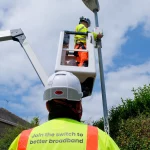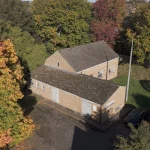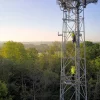Ookla Examine WiFi 6 vs 7 Performance of EE’s UK Broadband Routers

Internet connection benchmarking firm Ookla, which operates the popular Speedtest.net broadband and mobile testing service, has published an interesting new study that looks at the adoption of different WiFi standards and performance across the world. But the study also highlights the performance impact of EE’s (BT) new Wi-Fi 7 capable routers in the UK.
Before we get started, it’s important to understand that the data being used in this research is coming from web-based speedtests conducted by consumers, which is not exactly the most scientific or reliable way of comparing the performance between different generations of WiFi technology. Such testing can be impacted by various issues, such variable Wi-Fi signal strength between rooms, limitations of the tester itself or device being used, local network congestion and more.
Otherwise, Ookla’s new study reveals that legacy Wi-Fi standards continue to dominate in the UK and Europe, accounting for over 70% of connections in many European countries. For example, in the United Kingdom some 17.29% of Wi-Fi connections are still made using Wi-Fi 4, while Wi-Fi 5 has the biggest piece of the pie at 51.35% and Wi-Fi 6 follows on 31.02%. After that, the latest Wi-Fi 7 standard, which only really started to come into the market last year, holds just 0.35%.
Advertisement
However, despite Wi-Fi 7 having such a small share of the UK’s market, it’s worth nothing that this still puts the United Kingdom within the top 7 countries across Central and Western Europe for Wi-Fi 7 adoption. France currently tops this list on 1.48%, followed by Switzerland (0.85%), Denmark (0.6%), Sweden (0.5%), Germany (0.42%), the Netherlands (0.38%) and then the UK on 0.35%.
This is naturally influenced by various factors, with two of the biggest being consumer choice (i.e. many people often pick a broadband package with older kit and use it for years without upgrading / switching) and the capabilities of the broadband routers that ISPs choose to supply to their customers. In addition, each new Wi-Fi generation tends to be faster than the last, and ISPs often bundle the most capable kit with their fastest plans.
At present, EE is one of the only major broadband ISPs in the UK to bundle a Wi-Fi 7 capable router (Smart Hub Pro), which launched in September 2024 and means they’re also one of the few providers able to generate enough testing data to identify a performance impact. The charts below also include French ISP ‘Free’, which has done something similar to EE.

Advertisement
Ookla’s Speedtest Intelligence data shows that median download speeds on Wi-Fi 7 with EE’s fixed broadband reached 665.01Mbps (download) at the end of 2024 — more than four times the performance recorded on EE-based Wi-Fi 6 connections during the same period. EE’s median upload speeds on Wi-Fi 7 were also nearly twice as fast on EE compared to Wi-Fi 6 connections.
Interestingly, median latency on EE’s Wi-Fi 7 connections in the UK also reached just 17ms (lower figures are faster) at the end of 2024, a 12% improvement over Wi-Fi 6. This is despite the fact that latency, unlike download and upload speeds, is not usually as directly influenced by the impact of ISPs bundling Wi-Fi 7-capable routers (CPE) with higher-tier tariff speeds.
The results are interestingly, but much as we said earlier, testing WiFi performance using web-based speedtesters is subject to many caveats and so should be taken with a suitable pinch of salt.
Mark is a professional technology writer, IT consultant and computer engineer from Dorset (England), he also founded ISPreview in 1999 and enjoys analysing the latest telecoms and broadband developments. Find me on X (Twitter), Mastodon, Facebook, BlueSky, Threads.net and Linkedin.
« ISP Sky Broadband UK Promises to Fix Router WiFi Calling Bug





















































Am I missing something here? How does Ookla know what a particular device is using in relation to a particular wifi network? Surely, it is just recording the download and upload speeds which might be from a fully wired connection. To my uniformed mind, all that this particular piece of ‘research’ shows is that customers on the fastest lines are electing for a wifi7 capable router whether or not they have any wifi 7 capable. devices.
I did – I didn’t have any before I got EE. I do now. But most people just accept what they are given with the package.
If you run a speed test using their app, it knows your hardware amd network capabilities.
Find it very interesting that the upload results for EE on WiFi 5 & 6 are that low.
It’s almost like they’ve deliberately lowered them as it wouldn’t fit the narrative they are trying to push that WiFi 7 is the next best thing since sliced bread
It’s not really that surprising when you consider that WiFi 7 broadband speeds are very likely to be 900Mbps+ mostly (otherwise what’s the point) which would be an upload speed of 110Mbps or thereabouts.
Wifi 5 is a wide range of varying speeds and WiFi 4 being even older, there may well be quite a few DSL scores in there that will bring the average upload down considerably.
@Fr-ChewyLewy
My point was with EE’s upload being capped to around 110Mbps if the same line type & speed setting they used for the WiFi 7 test was also used for WiFi 5 & 6 tests then theoretically it would be the same as the WiFi 7 results.
I’m with EE but use TP Link Deco which are WiFi 6
Regularly see 700Mbps+ to my Google Pixel 9 Pro XL so all this really shows is EE/BTs WiFi 6 provision is poor at best
or it shows that you can’t compare your one data point vs the hundreds or thousands of tests Ookla’s users have run.
I suspect that if the data was pulled on Deco users, you’d see the same thing. Especially in the world of wifi where there are so many variables.
I can’t buy a Wifi 7 card for my laptop they only seem to be available for Intel CPUs (mine is AMD). I just got 1366 Mbs / 1082 Mbs on speedtest.net over Wifi 6 (this is with Zen 2.3/2.3) – 5 m from the router. Latency is 14 ms. It will be interesting to see how close Wifi 7 gets to wired performance when Wifi 7 cards become available.
You can get a USB one, but I doubt you will notice much difference. I use Ethernet for as much as I can and the stuff I can’t, I am not really that bothered about. Saying that, I even got my printers connected via Ethernet, more reliable.
My router is Wi-Fi 6, and I am not planning on changing it just to get a bit more speed on Wi-Fi.
Wifi cards aren’t CPU specific mate
@Andrew you would think so but unfortunately Intel have made it so their Wifi 7 card only works with Intel CPUs and it is the only widely available Wifi 7 card at the moment. MediaTek and Qualcomm do have universally compatible Wifi 7 chips but I can’t find them available to buy in m.2 form factor.
I, too, like using multi-gigabit broadband via an ISP-provided potato masquerading as a router.
Or, rather, I don’t.
Erroneous information is erroneous.
WiFi isn’t “broadband” unless we’re talking WiMAX (we’re not).
I tire of numpties conflating “WiFi” with “internet”. It now being conflated with “broadband” is just the icing on an already incredulous cake.
For the majority of people, the router supplied by the ISP is fine and does the job. As long as they can watch what ever they want to watch, play their games and do what ever else they do, then why would they be bothered?
Chatting to someone at work this week who have been pushed to go onto FTTP, she says it will stop her TV from buffering, I learnt from further conversation that it is only the TV downstairs, which is strangely enough under the router :). I told her it is not going to make a scrap of difference. They need to find out what the problem is with their TV as that is the problem, not the broadband or router.
It could be the fire stick.
I agree with you that people do confuse broadband, Wi-Fi and internet, thinking it is the same thing, not that I hear the internet word much these days.
You only have to blame the big ISPs, they are the ones who make it confusing. Watch the adverts.
Looked at the source report. Meh. If you have decent Wi-Fi all over your property then you are done. You don’t need 7 for that. You probably do need some ethernet cabling and wireless mesh to sort things properly. Use cases…what are people trying to do? For me 4k streaming every where and decent speed to update devices on wireless is what I want (including Wi-Fi to where the car is parked for SatNav updates). Big game loads via wired ethernet mainly because online gaming will be via a wired connection for my Xbox to get the lowest ping possible. Main TV on a cable too because streaming has be seamless every single time on that screen. I own zero Wi-Fi 7 devices. 50Mb min. is fine for all my wireless needs, 1Gb is massive over kill for the Xbox on a cable. Some of my mesh devices are wired back to my main switch next to the ONT so I don’t get any delays. Wi-Fi is a time based service (educating myself on this was a game changer), Wi-Fi interference is a rubbish way to describe some issues. A job for sometime will be wiring all the mesh units up.
Your opinions On broadband Speeds Are Subjective AF